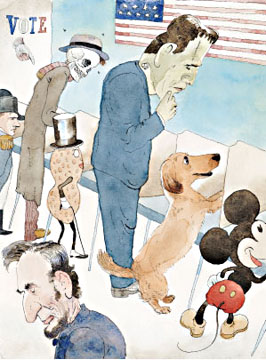Hey, guess what? My piece about voter fraud in the latest issue of the magazine, “The Dog That Voted,” is now out! The origins of the Republican crusade against voter fraud can be traced back to a lot of sources, but for all practical purposes it turns out that you can peg it to the 2000 election fiasco. Not the famous one in Florida, but the less famous one in Missouri, which produced three Republicans dedicated to pushing the cause of photo ID thoughout the country: John Ashcroft, the embittered U.S. senator who lost his reelection bid that night and went on to become George Bush’s Attorney General; Kit Bond, Missouri’s other senator, who went on to write the first-ever  federal voter ID provision; and Mark “Thor” Hearne, who went on to become national counsel for the 2004 Bush campaign and then started up the American Center for Voting Rights, an organization funded by dark money and dedicated to spreading fear of vote fraud throughout state legislatures across the country. It was a lengthy campaign, but in the end it was a very effective one:
federal voter ID provision; and Mark “Thor” Hearne, who went on to become national counsel for the 2004 Bush campaign and then started up the American Center for Voting Rights, an organization funded by dark money and dedicated to spreading fear of vote fraud throughout state legislatures across the country. It was a lengthy campaign, but in the end it was a very effective one:
In retrospect, the campaign against voter fraud was long, patient, and strategic. Sen. Kit Bond got the ball rolling in 2002 when he made sure ID requirements were part of HAVA. In 2005, a commission on voting rights headed by former president Jimmy Carter and former Secretary of State James Baker III gave a bipartisan blessing to photo ID rules. Thor Hearne spent the following two years barnstorming the country with dramatic tales of voter fraud. Meanwhile, the Justice Department and the Bush White House browbeat US Attorneys around the country to crack down on voter fraud, even firing a handful (including David Iglesias, then the US Attorney for New Mexico) who apparently weren’t zealous enough. And then, finally, the 2010 election brought new GOP majorities to 11 states—and with them a brand new wave of restrictive voting laws.
So: why are Republicans so obsessed with voter fraud? And how effective are photo ID laws at suppressing left-leaning votes? The answers to both of these questions are a little less obvious than you might think. But it’s a fascinating story. Check it out here.


















